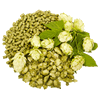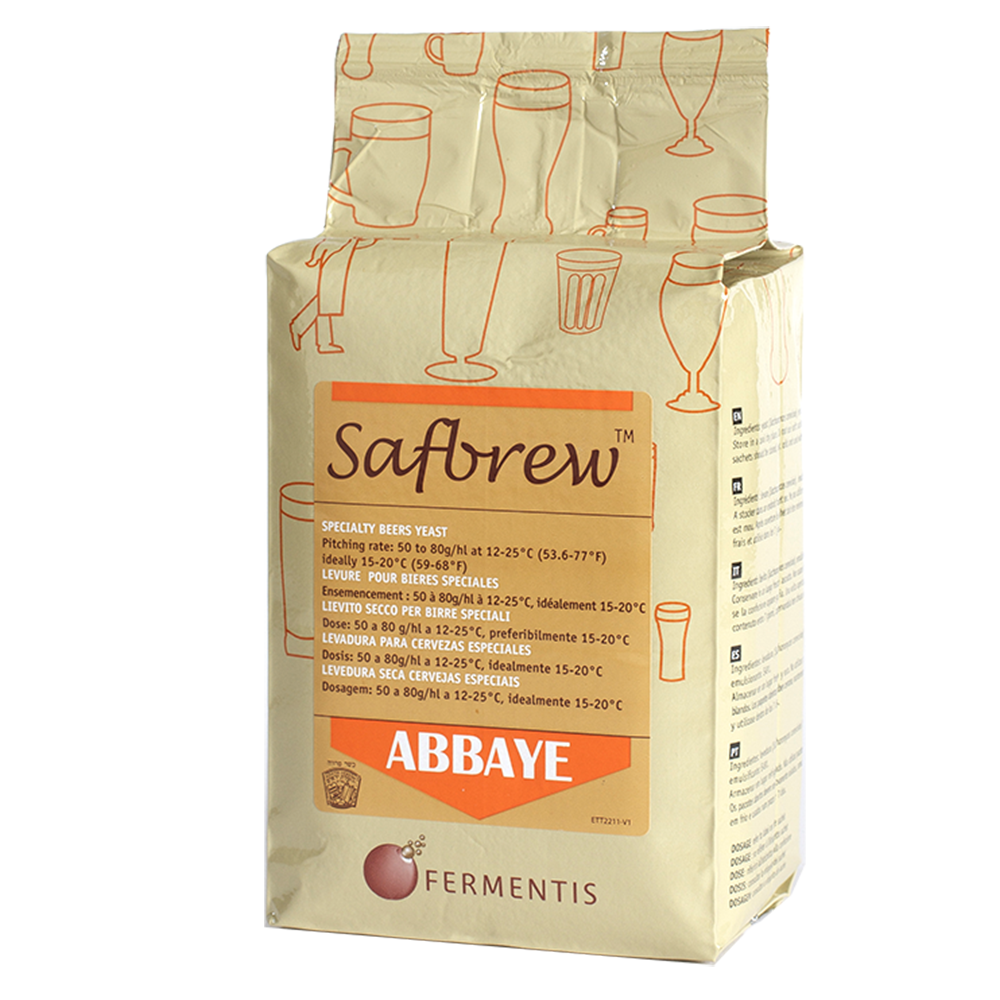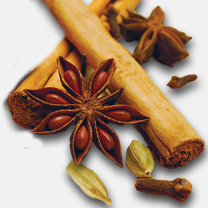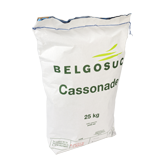Nouvelles de la société
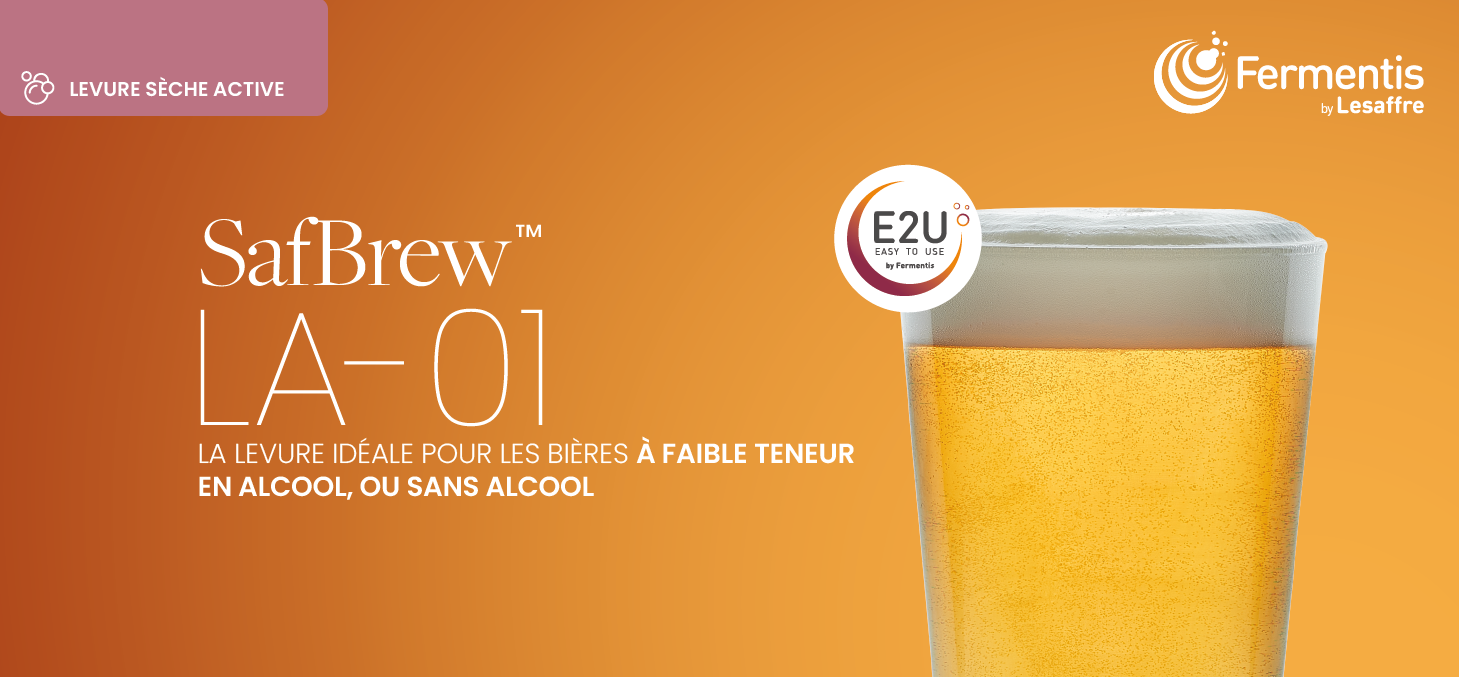
Chers Brasseurs,
Avec l’arrivée du Dry January, c’est le moment idéal pour développer ou renforcer votre offre de NABLAB, sans faire de compromis sur le goût ni la créativité.
En tant que distributeur officiel Fermentis, Artisan Brasseur vous propose des solutions de fermentation pour toutes vos bières. Parmi elles, SafBrew™ LA-01 est la levure idéale pour les bières à faible teneur en alcool ou sans alcool.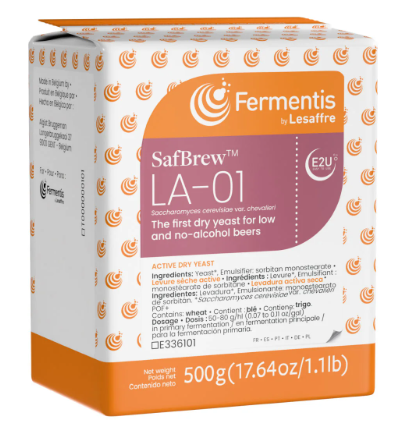
SafBrew LA-01 – la levure la plus polyvalente pour NABLAB :
- La première levure sèche pour les bières sans alcool et à faible teneur en alcool.
- Une souche maltose-négative qui ne fermente pas le maltose ni le maltotriose, idéale pour rester sous 0,5% vol. tout en gardant des sucres résiduels maîtrisés.
- Un profil aromatique délicat et propre, avec des esters et alcools supérieurs très faibles pour des bières nettes et faciles à boire.
- Une sédimentation moyenne qui ne forme pas de grumeaux, mais un voile pulvérulent lorsqu’elle est remise en suspension dans la bière.
- Une mise en œuvre simple : le confort du label E2U™ (Easy to Use) : réhydratez ou ensemencez directement, selon vos équipements et vos habitudes.
Découvrez comment les brasseries La Rouget de Lisle et Aux Enfants Terribles ont enrichi leurs gammes de bières uniques grâce à la levure SafBrew™ LA-01 :
Brasserie La Rouget de Lisle (France) : retour d’expérience sur la création de bières sans alcool gourmandes et identitaires.
Brasserie Aux Enfants Terribles (France) : focus sur l’intégration de bières sans alcool dans une carte créative et moderne.

La levure SafBrew™ LA-01 vous permet de brasser une large gamme de bières sans alcool et à faible teneur en alcool, adaptées aux attentes des consommateurs en matière de bien-être :
Bières acides via kettle-souring, en jouant sur le pH pour compenser le manque d’alcool et apporter du relief.
Bières houblonnées et IPA à faible teneur en alcool, grâce à des profils aromatiques travaillés par le houblonnage à froid.
Styles belges et épicés tirant parti du léger caractère phénolique (notes épicées / clou de girofle) de la souche.
Stouts, porters ou autres styles plus maltés, en jouant sur les malts spéciaux pour enrichir la complexité aromatique.
SafBrew™ LA-01 est disponible en conditionnement de 500g et de 10kg.
Bien cordialement,
Les équipes Malterie du Château

Chers Brasseurs et Distillateurs,
Nous avons le plaisir de vous annoncer l’arrivée en France des malts emblématiques de Bairds Malt.
Depuis 1823, Bairds Malt perpétue la tradition et le savoir-faire britannique dans l’art du maltage. Convaincue que les plus grands whiskies et bières naissent des malts les plus nobles, Bairds Malt sélectionne l’orge britannique de la plus haute qualité aux côtés de plus de 800 agriculteurs partenaires. Entre respect des traditions et goût pour l’innovation, Bairds Malt propose ainsi aux brasseurs et distillateurs du monde entier des malts d’exception.
Aujourd’hui, deux références phares rejoignent notre gamme pour sublimer vos créations :

Le Malt Extra Pale Ale
• Une couleur exceptionnellement pâle, plus claire que celle d’un malt Lager
• Le choix idéal pour des XPAs, Pale Ales, IPAs et Blondes
• Parfait pour des bières houblonnées, intensément aromatiques et à la robe trouble

Style de bière: Pale Ales modernes, IPAs
Profil aromatique : Apporte une couleur dorée et des arômes maltés intenses
Utilisation: Jusqu’à 100%
Humidité (% min) : 4,0
Extrait fine mouture (% min) : 80,0
Protéines totales (% max) : 10,6
Coloration (EBC) : 2,5 – 4,4
Pouvoir diastasique (KW min) : 140
Kolbach (%) : 40,0 – 45,0.

Le Malt Maris Otter®
• Une variété d’orge emblématique du Royaume-Uni, cultivée principalement dans la campagne anglaise et appréciée par les plus grands brasseurs du monde depuis plus de 50 ans
• Le choix de référence pour brasser d’authentiques bières britanniques de type Ales
• L’ingrédient principal des recettes de Pale Ales traditionnelles anglaises

Style de bière : Best Ales
Profil aromatique : Apporte des notes douces et complexes de biscuit
Utilisation : Jusqu’à 100%
Humidité (% min) : 4,0
Extrait fine mouture (% min) : 80,5
Protéines totales (% max) : 10,6
Coloration (EBC) : 4,4 – 6,6
Pouvoir diastasique (KW min) : 140
Kolbach (%) : 40,0 – 45,0
Disponibles en sacs de 25 kg.
Bien cordialement,
Les équipes Malterie du Château

Chers Brasseurs et Distillateurs,
La Malterie du Château a le plaisir de vous présenter CHÂTEAU CARA ULTRA, une nouvelle génération de malts caramélisés.
Récompensée au concours Brassinov 2025 lors du Salon du Brasseur de Nancy, cette innovation repose sur une technologie exclusive de saccharification à la vapeur, garantissant une caramélisation complète et homogène des grains.
Les + de CHÂTEAU CARA ULTRA
- Intensité exceptionnelle de ses arômes de caramel
- Moindre amertume et astringence pour une douceur incomparable
- Renforce le corps des bières spéciales
- Favorise une mousse dense et persistante
Deux références pour une large palette aromatique
CHÂTEAU CARA ULTRA 60 EBC
- Arômes intenses de caramel doux
- Idéal pour lagers, ales légères, IPA, bières ambrées
- Utilisation jusqu’à 30%
CHÂTEAU CARA ULTRA 150 EBC
- Arômes profonds de caramel et de toffee
- Parfait pour brown ales, lagers foncées, bocks, bières spéciales
- Utilisation jusqu’à 20%

Découvrez également toute notre gamme de malts caramel
- Plus de 20 références aux profils aromatiques variés
- Une gamme complète : Château Cara Clair®, Château Cara Blond®, Château Cara Belgium, Château Cara Ruby®, Château Cara Honey, Château Cara Gold®, Château Cara Crystal®, Château Cara Terra®, Château Special Belgium®, Château Cara Café® et maintenant Château Cara Ultra 60 et 150
- Des malts durables issus de l’agriculture biologique
- Des malts 100% orge 2 rangs de printemps
Profitez de malts caramélisés d’exception pour sublimer toutes vos créations brassicoles.
Contactez-nous pour en savoir plus.
L'équipe de la Malterie du Château

Chers Brasseurs,
Nous sommes ravis de vous annoncer que le malt CHÂTEAU RED INTENSE est désormais disponible en stock !
Ce malt spécial offre une teinte rouge éclatante et homogène à vos bières tout en apportant des saveurs maltées profondes – le tout sans aucun colorant.
Pourquoi choisir le CHÂTEAU RED INTENSE ?
Couleur rouge naturelle (34–38 EBC) avec faible turbidité
Des saveurs maltées exceptionnellement riches
Utilisable jusqu’à 100 % grâce à son pouvoir diastasique suffisant
Idéal pour brasser des Red Ales belges ou irlandaises, des Red IPAs, Red Lagers, Altbiers ou encore des Sours
Disponible en sacs de 25 kg.
Simplifiez votre brassage et obtenez une couleur rouge éclatante, naturellement.
Contactez-nous pour en savoir plus.
Bien cordialement,
L'équipe de la Malterie du Château

Parce que nous avons à cœur de vous offrir les meilleures solutions pour vos bières et vos spiritueux, nous sommes fiers d’être le distributeur officiel de Fermentis by Lesaffre en France, Belgique et aux Pays-Bas. Ce partenariat nous permet de mettre à votre disposition une gamme complète de levures reconnues pour leur qualité et leur performance.
Qui est Fermentis ?
Fermentis est une division du Groupe Lesaffre, entreprise française et acteur majeur mondial de la fermentation depuis plus d'un siècle. Spécialisée dans le développement, la production et la commercialisation de solutions pour les boissons fermentées, Fermentis accompagne les brasseurs, distillateurs, et tous les producteurs de boissons fermentées à travers le monde pour répondre à leurs besoins spécifiques.
Son expertise repose sur :
- Une équipe internationale d’experts
- Un programme R&D de pointe
- Un savoir-faire industriel conforme aux standards de qualité les plus exigeants
La vision de Fermentis ? Devenir le choix évident des brasseurs, des viticulteurs et de tous les producteurs de boissons fermentées, en les aidant à innover et exprimer leur créativité.
Une gamme complète pour les artisans brasseurs et distillateurs
Grâce à notre partenariat, nous distribuons les solutions Fermentis adaptées à tous les styles de bières et de spiritueux :
- Levures sèches pour les brasseries artisanales et industrielles
- Levures sèches pour les distilleries
- Bactéries pour fermentation lactique et acidification contrôlée
- Solutions techniques pour optimiser la production et améliorer les profils sensoriels
Ces produits sont conçus pour répondre aux besoins spécifiques des brasseurs, qu’ils recherchent performance, régularité ou originalité.
Pourquoi choisir Fermentis avec la Malterie du Château ?
En tant que distributeur officiel, nous vous assurons :
- Disponibilité et réactivité
- Conseils techniques personnalisés
- Accès à une gamme complète et innovante
Grâce à notre partenariat avec Fermentis, vous avez l’assurance de travailler avec des partenaires engagés pour la qualité et la créativité. Découvrez dès maintenant notre sélection de produits Fermentis sur notre site.

Du 2 au 5 novembre, la ville de Marche-en-Famenne est devenue la capitale internationale de
la bière à l’occasion du Brussels Beer Challenge, rassemblant 70 experts venus du monde
entier pour juger plus de 1700 bières.
Parmi ce jury d’exception, nous étions fiers d’être représentés par Mattijs Nuyts, notre
commercial pour la Belgique, les Pays-Bas et l’Europe du Nord chez Malterie du Château.
Son expertise en zythologie et son engagement auprès des brasseurs font de lui un
ambassadeur passionné de notre filière.
À travers sa présence, Malterie du Château réaffirme son soutien à la filière brassicole, à la
créativité des brasseurs et à l’excellence des produits. Ce concours est une vitrine
internationale pour les talents et les savoir-faire qui font rayonner la bière artisanale.
Bravo à tous les participants et lauréats !
Découvrez les résultats ici



Alors que nous entrons en 2025, il est temps d’examiner de plus près comment la récolte d’orge 2024 influence la qualité du malt pour la saison de brassage à venir. Le Rapport sur la Récolte d’Orge 2024 fournit des informations essentielles sur les conditions de semis, de croissance et de récolte qui ont façonné les caractéristiques du malt et les processus de brassage pour l’année à venir.
Que contient le rapport ?
Conditions de semis, de croissance et de récolte: Aperçu des défis et des résultats clés de la saison de culture 2024.
Impact sur la qualité du malt: Découvrez comment ces conditions ont influencé les caractéristiques du malt, notamment la teneur en protéines, les valeurs d'extrait et la couleur, et ce que cela signifie pour les brasseurs en 2025.
Ajustements lors du brassage: Conseils d'experts pour adapter votre processus de brassage aux spécificités du malt issu de la récolte 2024.
Pourquoi les brasseurs doivent-ils lire ce rapport ?
Comprendre l'impact de la récolte d’orge 2024 sur les caractéristiques du malt est essentiel pour optimiser votre processus de brassage en 2025. Que vous ajustiez l'utilisation de votre malt ou modifiiez vos paramètres de brassage, ce rapport vous apporte des informations précieuses pour obtenir les meilleurs résultats dans votre brasserie.
Lisez le rapport complet sur la Récolte d’Orge 2024 et commencez dès aujourd’hui à affiner votre approche du brassage !
Bonjour,
Fermentis et la Malterie du Château ont le plaisir de vous inviter à la Fermentis Academy : il s’agit d’une journée de formation destinée aux brasseurs, qui aborde différentes thématiques et aspects techniques autour de la levure, de la fermentation ainsi que du malt . A travers ces Fermentis Academy, nous souhaitons partager avec vous les connaissances dont nous disposons aujourd’hui et nous pourrons également répondre à toutes vos questions.
Vous souhaitez participer ?
Rendez-vous le vendredi 15 Décembre de 8h30 à 16h30, à la Brasserie De Sutter située au 15 Route de Paris, 27140 à Gisors
Comment vous inscrire ?
Cliquez sur le lien suivant et suivez la procédure d’inscription:
Nous vous attendrons à la brasserie à partir de 8h30 pour un café/petit-déjeuner et la formation commencera à 8h45.
Sur le temps de midi, un déjeuner vous sera proposé, ainsi qu’une visite de la Brasserie De Sutter.
Pour ceux qui le souhaitent en fin de journée, nous pourrons partager un moment convivial autour d’une bière.
Nous demandons, à chaque participant, un montant de 25 €, qui inclut la formation dispensée et le déjeuner.
Si vous avez des questions, n’hésitez pas à contacter Fermentis :
Enguerrand ABT
E.abt@fermentis.lesaffre.com
En espérant vous compter parmi nous !
Cordialement
Équipe de la Malterie du Château

L'équipe de La Malterie du Château® vous adresse une invitation chaleureuse et enthousiaste à nous rejoindre à BrauBeviale 2023! Notre stand, numéro 336 dans le Hall 1, vous attend au parc des expositions de Nuremberg, en Allemagne, du 28 au 30 novembre.
Notre stand n'est pas seulement un lieu, c'est un centre de conversations engageantes et d'interactions enrichissantes. Nous sommes impatients d'explorer les derniers développements dans les industries brassicoles et de maltage, à la fois à l'échelle nationale et internationale.
N'hésitez pas à poser vos questions sur nos produits et services ; nous sommes là pour vous fournir les informations dont vous avez besoin. Et, en prime, nous vous offrirons l'opportunité de déguster les dernières créations belges de brasserie artisanale - une expérience vraiment unique !
BrauBeviale est sur le point de revenir plus fort que jamais, avec plus de 900 exposants répartis sur 40 000 mètres carrés d'espace d'exposition. L'événement présente un Forum d'experts, un espace logistique et le point culminant du concours européen de la bière 20th European Beer Star, qui a attiré plus de 500 candidatures impressionnantes de brasseurs de 44 pays.
Cette réunion promet d'être une célébration de la diversité, de la liberté, de la résilience, et un pôle d'interaction commerciale qui favorise de nouvelles idées audacieuses et la créativité.
Nous sommes ravis de vous offrir l'occasion exclusive de recevoir des billets gratuits pour BrauBeviale 2023 !
Code d'accès: BB23CASTLEMALTING
Pour garantir la planification de votre visite, n'hésitez pas à nous contacter en envoyant un courriel à marketing@castlemalting.com pour planifier une réunion. Il vous suffit de nous informer de la date et de l'heure qui vous conviennent, et vous recevrez une confirmation rapide.
Votre présence à BrauBeviale 2023 la rendra d'autant plus exceptionnelle, et nous attendons avec impatience le plaisir de votre compagnie.
Au plaisir de vous rencontrer à Nuremberg !

5 janvier 2023
Beloeil, Belgique
Cher Client et Partenaire,
Depuis presque 20 ans pour certains d’entre vous, nous avons travaillé ensemble, main dans la main, pour développer et vous fournir les meilleurs malts au monde.
Le chemin a été rocailleux dans les premières années, mais nous y avons cru, et aujourd’hui nous sommes leader mondial dans notre secteur, exportant, dans 145 pays et à plus de 3600 Brasseurs, plus de 100 variétés de malts différents.
Actuellement, nous sommes au sommet de notre art, pour servir les clients qui sont au coeur de nos activités de Maltage: les petits et les moyens Brasseurs.
Malheureusement, ces deux dernières années, nous avons constaté que, de plus en plus fréquemment, nous n’étions plus aptes à le faire correctement, comme vous le méritez, par manque de capacités de maltage.
Nous avions le choix, soit de continuer comme avant, ou d’être logique avec nous-mêmes, et vouloir maintenir un niveau de services comme vous avez pu l’apprécier pendant de nombreuses années.
Devant ce dilemme, la solution logique que nous avons adoptée est de nous associer avec un leader mondial dans le secteur malterie: Malteries Soufflet – le groupe InVivo.
Je comprends parfaitement que, pour certains d’entre vous, vous vous posiez des questions sur notre avenir. Mais je peux vous rassurer, car l’un des éléments fondamentaux de la transaction est que Malteries Soufflet – le groupe InVivo préservera notre usine, notre structure, notre ADN, et désire ardemment maintenir notre approche très relationnelle et personnalisée avec chacun d’entre vous.
Toute l’équipe de La Malterie du Château reste en place et se fera un plaisir de vous servir comme par le passé, et même mieux grâce à l’aide de notre nouveau partenaire.
Quant à moi, je resterai dans la société le temps qu’il faudra, afin d’assurer la transition la plus harmonieuse possible avec l’équipe Malteries Soufflet pour que La Malterie du Château continue de vous servir comme avant.
Je tiens aussi à remercier chacun d’entre vous qui m’a fait confiance depuis tellement d’années, à tel point que beaucoup sont devenus des compagnons de route depuis l’explosion du nombre des petits brasseurs.
Nous sommes très fiers d’y avoir contribué en développant un service global, pour faciliter la vie de chacun d’entre vous.
Encore bonne continuation et succès pour tous.
Jean-Louis Dourcy
Directeur
PS: N’hésitez pas à m’appeler si nécessaire
Tel: 0032498122667

La Malterie du Château® a remporté la médaille d'or aux Global Brewing Supply Awards 2022 !
La Malterie du Château® SA (Castle Malting), la plus ancienne malterie de Belgique, produisant plus de 100 types de malt pour les brasseries artisanales dans 147 pays à travers le monde, annonce qu'elle a été nommée aux RMI Analytics Global Brewing Supply Awards 2022, le 30 mars 2022. Ce prix confirme l'engagement de La Malterie du Château® envers l'innovation continue, le développement durable et l’optimisation dynamique de la chaîne d'approvisionnement. Il souligne aussi le dévouement de La Malterie du Château® à fournir les meilleurs services et à offrir des malts de base et de spécialité de la plus haute qualité.
« Nous sommes reconnaissants à toute notre équipe pour leur consécration à construire chaque jour de notre histoire ! Nous sommes honorés de faire partie de cette noble compétition pour apporter plus de valeur et de meilleurs services dans l'industrie de la bière, tout en préservant notre environnement pour les générations futures », a déclaré Jean-Louis Dourcy, PDG de La Malterie du Château®.
À propos de La Malterie du Château® : Fondée en 1868, La Malterie du Château® est la plus ancienne malterie de Belgique et l'une des plus anciennes malteries familiales au monde. La Belgique, la patrie de La Malterie du Château®, est probablement l'endroit le plus proche du paradis pour la plupart des amateurs de bière, la culture de la bière belge étant reconnue par l'UNESCO comme faisant partie du patrimoine culturel immatériel de l'humanité. Pour répondre aux exigences de qualité de cette énorme variété de bières, La Malterie du Château® a développé toute une gamme de malts de base et de spécialité, de qualité premium, offrant aujourd'hui la plus large gamme de malts au monde.
La qualité premium de plus de 100 types de malts de base et de spécialité Château est la garantie du succès pour plus de 3500 brasseries dans 147 pays à travers le monde entier. Les malts Château permettent de brasser n'importe quel style de bière, des bières Pilsner et Blanches aux bières brunes d'Abbaye, Stouts et Porters ainsi que n'importe quel style de bière biologique.
À propos de RMI Analytics : Premier fournisseur mondial d'informations sur le marché pour la chaîne d'approvisionnement internationale des matériaux de brassage. Fondée en 1999 et basée en Suisse, RMI Analytics utilise ses multiples partenariats avec les principales entreprises pour fournir la seule source impartiale au monde de données sur l'orge, le maltage et le brassage.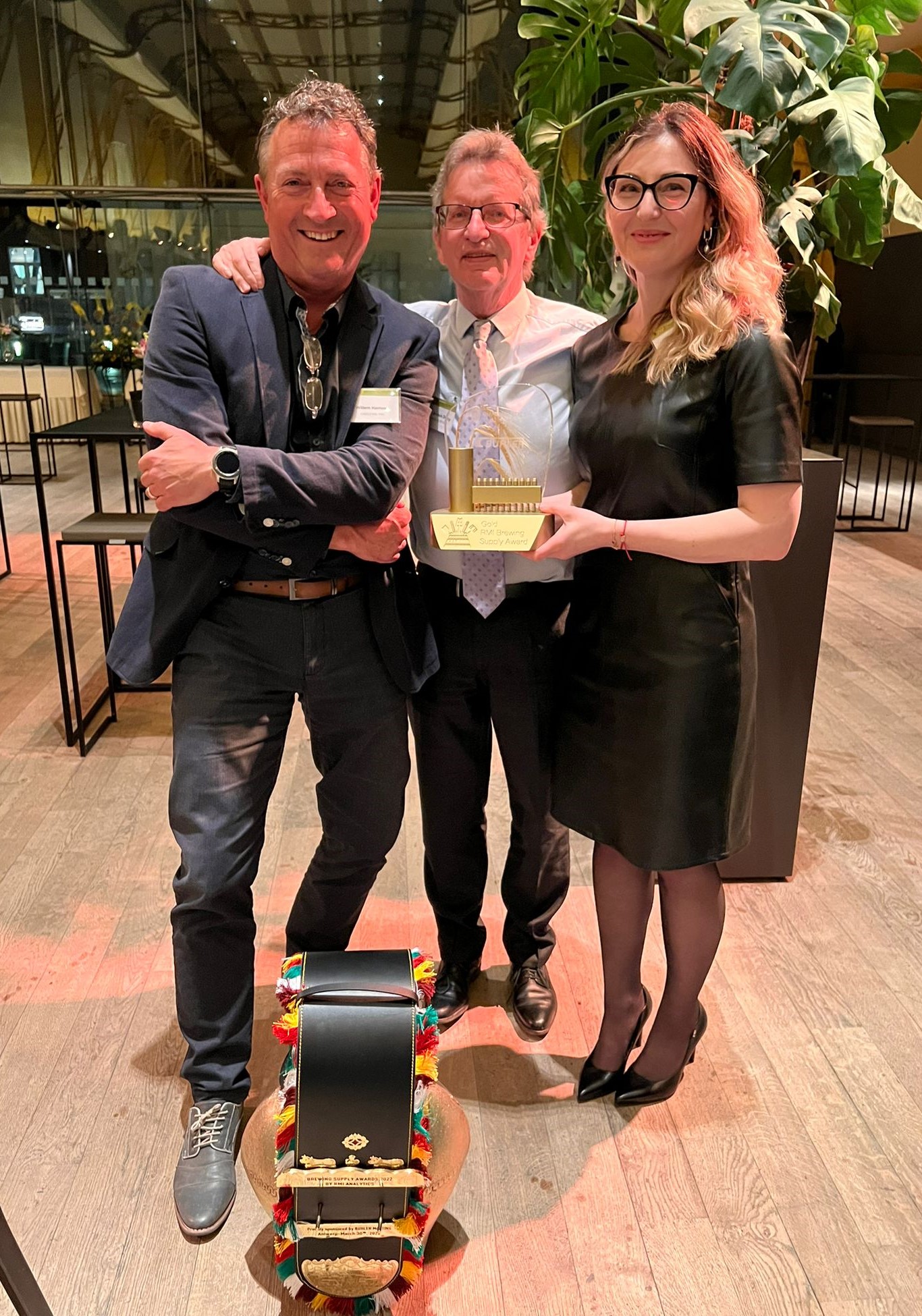

Grâce à la détermination et à la bienveillance de notre équipe, nous avons aidé 106 réfugiés ukrainiens à commencer une nouvelle vie en Belgique, loin de la terreur et de la destruction qui ravagent leur patrie.
Deux bus, deux semaines sur la route, des contrôles aux frontières qui semblaient interminables, des nuits blanches, de la fatigue, et pourtant - bonheur, sourires, gratitude et espoir - tout cela en valait la peine. Le plus jeune réfugié qui a voyagé avec nous n'avait que quelques mois, le plus âgé était une grand-mère de 83 ans. Et quelle joie ce fut de voir des lueurs d'espoir dans les yeux de tous, une fois arrivés à destination.
Maintenant Ils sont tous en Belgique, vivent dans des familles d'accueil locales et reçoivent l'aide de la communauté. Ils ont un toit au-dessus de leur tête et ils ont commencé une vie paisible. Tous les enfants ont accès à l'école à proximité.
Notre récompense est un sentiment d'accomplissement incroyable et épanouissant. ❤ 
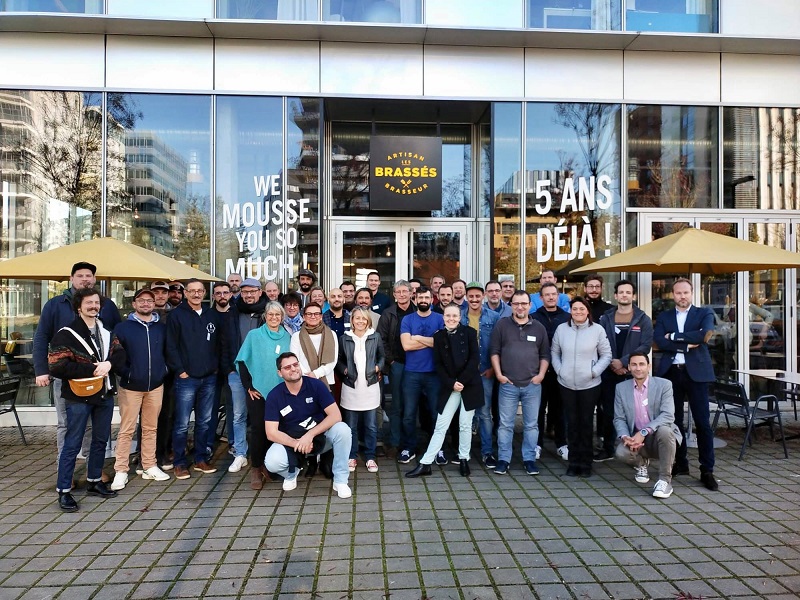
Quelques photos de notre agréable rencontre avec Il était une brasserie qui s'est tenue le mardi 9 novembre. Nous tenons à remercier Il était une brasserie et tous les brasseurs participants pour cette journée enrichissante ! 🍺
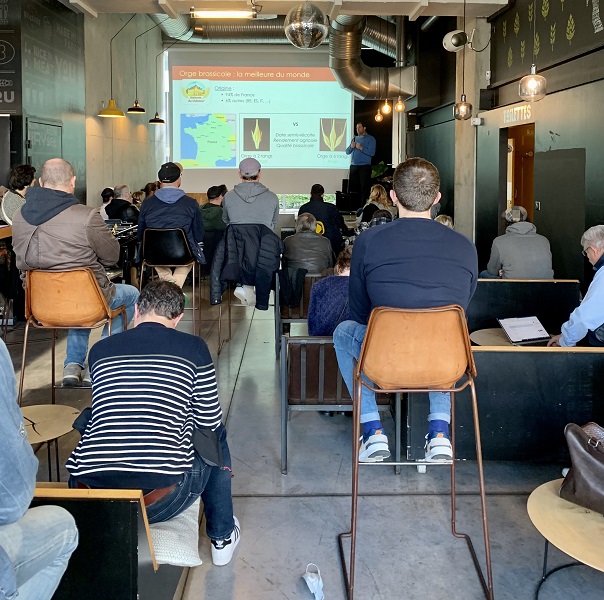

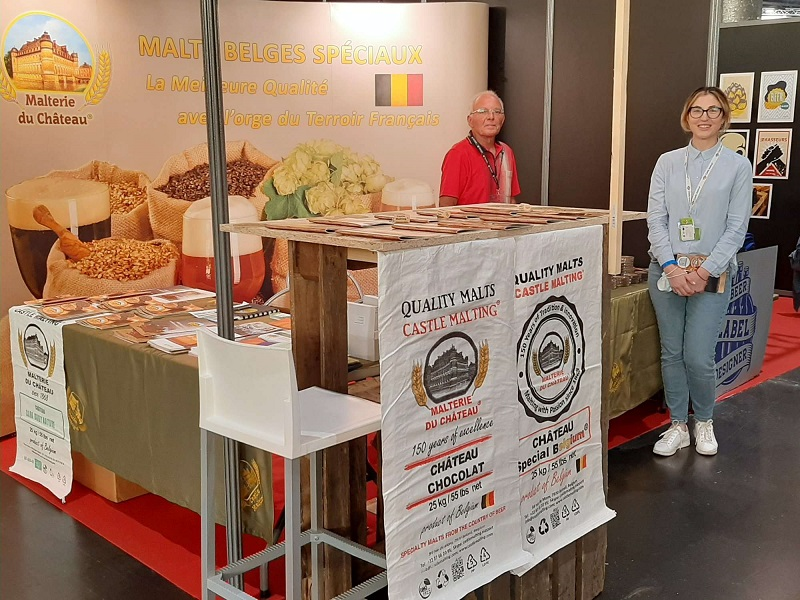
L'équipe de la Malterie du Château était heureuse de vous rencontrer au B A L - Bière à Lille 2021!
Merci de nous avoir rendu visite sur notre stand!


Nous avons été heureux de participer de nouveau à Oxfam Trailwalker - une randonnée de 100 km pour la bonne cause.
En équipe de 4, en moins de 30 heures, le 28 et 29 août, sur les sentiers ardennais et dans la lutte contre la pauvreté. Un pas vers un monde plus juste.
Nous sommes les champions!




SafSour LB-1 est une bactérie lactique hétérofermentaire. Elle a été sélectionnée par Fermentis spécialement pour sa capacité à fournir une acidité précise exprimée par une production combinée d’acides lactiques et acétiques.
SafSour LB-1 révèle également un profil aromatique neutre, respectant la signature aromatique de la levure dans le produit final. Nous la recommandons pour produire des Gose, Berliner Weisse et toutes autres bières aigres équilibrées.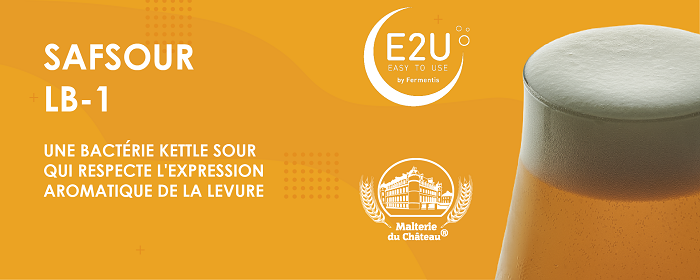

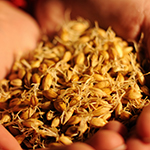
La Malterie du Château ne cesse d’innover. Les projets de recherche et développement y sont nombreux. Un des projets prioritaires porte sur l’utilisation du malt vert en brasserie. Aujourd’hui, plus que jamais, il est du devoir des industries de réduire leur empreinte écologique. Pour les brasseries, l’utilisation du malt vert est un moyen d’y parvenir, avec d’autres avantages à la clé. Voici de quoi mieux comprendre.
Pour rappel, on parle de malt vert pour désigner l’orge en fin de germination, juste avant son touraillage. A ce stade, il est intéressant de constater que le pouvoir enzymatique des grains est à son maximum, et qu’il est déjà possible de produire de la bière.
Quels sont les principaux intérêts de ce produit pour le brasseur?
Production de bières plus écologiques: En effet, le touraillage consomme ±70% de l’énergie dédiée à l’entièreté du processus de maltage. Pour chaque tonne d’orge à malter, on considère que le touraillage nécessite 550 à 650 kWh (sous forme de gaz, mazout, électricité, etc.). Par conséquent, en remplaçant une fraction du malt de base d’une bière par du malt vert, on réduit considérablement son empreinte écologique.
Haut pouvoir diastasique: Cela peut s’avérer particulièrement utile dans de nombreuses situations, notamment lors de l’ajout de céréales crues. Lors d’un projet co-dirigé par la Malterie du Château, des tests de saccharification se sont montrés concluants avec une fraction de 40% d’orge crue et le reste en malt vert. Voilà de quoi séduire les industriels, pour diminuer leurs coûts de production, mais aussi les micro-brasseurs, s’ils désirent utiliser des céréales locales sans nécessité de passer par un maltage-à-façon.
Augmentation de la filtrabilité: Certaines enzymes présentes en quantité dans le malt vert, telle que la β-glucanase par exemple, peuvent faciliter le process en accélérant la filtration. Les tests menés à la Malterie du Château ont montré qu’en remplaçant 20% du Pilsen d’une recette par du malt vert, la filtrabilité pouvait être doublée.
Moindre prix: Le malt vert est une matière première bon marché, puisque le malteur peut soustraire le coût de production lié au touraillage.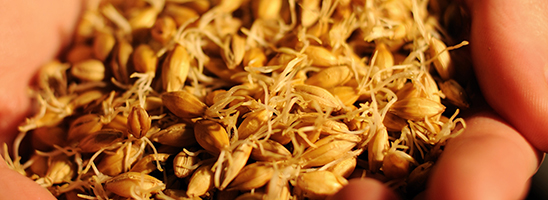
Toutefois, avant de parler de commercialisation, certains défis subsistent. Le concassage du malt vert ne pose pas de souci, s’il est réalisé sous eau (“wet milling”). Par contre, la conservation du malt vert est limitée à quelques jours à peine. Des essais sont en cours, à la Malterie du Château, pour évaluer l’impact des conditions de stockage et de différents types de conditionnements (en atmosphère sous vide, avec injection d’azote, etc.) sur la durée de conservation du malt vert. Enfin, certaines mesures devront être prises et le processus devra être adapté, tant par le malteur que par le brasseur, pour prévenir certains effets indésirables, en termes de faux-goûts, d’aspect, ou de vieillissement des bières. Rien d’insurmontable.
La Malterie du Château met tout en œuvre pour être une malterie “verte”.
Par conséquent, l’utilisation du malt vert en brasserie est une thématique qui lui tient à cœur. Elle entend continuer à contribuer à la recherche dans ce domaine. De nombreux essais sont d’ailleurs en cours afin de répondre aux défis mentionnés dans cet article.
Cet article a été publié dans le Bière Magazine en 2020
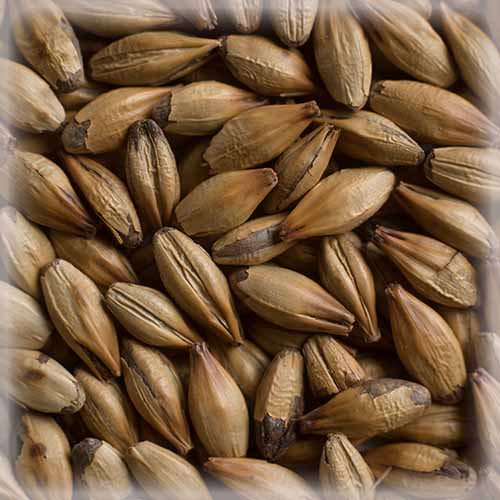
Château Spécial B® est un type de malt historique qui trouve son origine en Belgique et est utilisé dans une large gamme de fameuses bières belges. Le "B" signifie Belgique et, pour le préciser, la Malterie du Château a décidé d'opter pour l'appellation Château Spécial Belgium®.
Avec un nouveau nom mais toujours avec les mêmes saveurs et arômes, Château Spécial Belgium® est un malt belge foncé très spécial, produit par la Malterie du Château grâce à un process spécifique à double torréfaction.
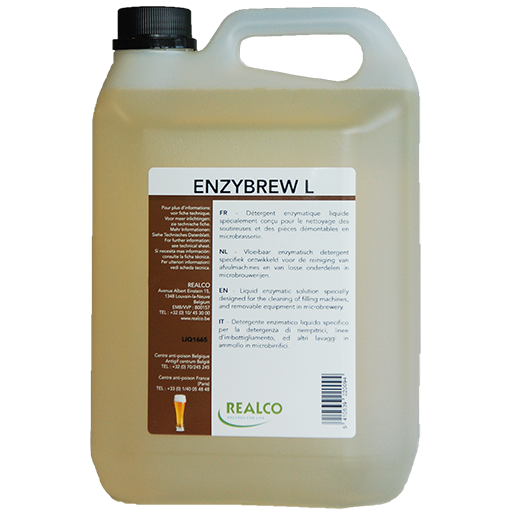
La Malterie du Château® vous propose un nouveau produit de nettoyage - ENZYBREW L, développé par la société belge REALCO®.
L’ENZYBREW L est un détergent enzymatique liquide spécialement conçu pour le nettoyage en trempage des soutireuses et des pièces démontables (vannes, flexibles, raccords,...) en microbrasserie. L’ENZYBREW L dégrade totalement les souillures organiques telles que les résidus protéiques et polysaccharidiques. Formulé sans phosphore, le produit assure un nettoyage en profondeur et éco-responsable.
AVANTAGES
• Hygiène renforcée : nettoyage en profondeur grâce aux enzymes (suppression des déchets organiques) et préparation efficace à la désinfection
• Suppression du risque de contamination
• Très bonne rinçabilité : produit non moussant
• Sans danger pour l’utilisateur : produit non corrosif (pas de risque de brûlure) et non classé
• Qualité organoleptique du produit garantie
• Alternative à la soude caustique respectueuse de l’environnement
L’ENZYBREW L est déjà disponible en stock à la Malterie du Château! Ajoutez-le à votre prochaine commande de malt pour optimiser les frais de port.
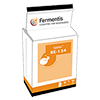
La Malterie du Château® ajoute une nouvelle référence à sa gamme de levure - SafAle™ BE-134 de Fermentis®. Cette souche de levure de spécialité a été sélectionnée pour la production de bières de style Saison Belge. Elle est caractérisée par une atténuation très élevée et la production d’arômes fruités et épicés (notes de clou de girofle). Cette souche permet de brasser des bières rafraîchissantes, avec une excellente buvabilité.
La Levure SafAle™ BE-134 est déjà disponible en stock à la Malterie du Château®. Ajoutez-la à votre prochaine commande de malt afin d'économiser considérablement sur le coût de transport!
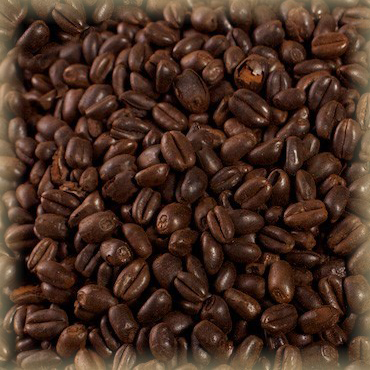
Caractéristiques : Malt Froment Chocolat. Le froment malté est torréfié à 230 ° C, puis refroidi rapidement lorsque la couleur désirée est atteinte.
Particularités : Le Malt Château Froment Chocolat est un malt très torréfié, mais pas autant élevé que le malt noir. Grâce à ce malt, une couleur brun foncé avec des notes de café noir et chocolat doux-amer peut être obtenue dans la bière. La version blé du malt Chocolat a un caractère de chocolat noir plus prononcé par rapport à la version de l'orge. Ce malt ajoute de la couleur et de la saveur à une grande variété de bières foncées et il est utilisé pour adoucir certaines bières brunes de style anglais, telles que les stouts, porteurs, ou ales brunes.
Le Malt Château Froment Chocolat à grain nu et a été spécialement développé par la Malterie du Château pour éviter l'astringence, l'amertume et le goût sec ou un arrière-goût dans les bières. Ce malt peut remplacer dans une proportion de 1: 1, le Malt Chocolat désamérisé *, ce qui confère une saveur plus douce.
* Le Malt Chocolat ou le Malt Black d’orge désamérisés sont des malts torréfiés avec la plupart de l'enveloppe retirée avant la torréfaction. Cependant, étant donné qu'il est impossible de retirer la totalité de l'enveloppe, et que c’est notamment de l'enveloppe que les notes amères se développent pendant la torréfaction, les malts torréfiés désamérisés apporteront une certaine quantité de saveurs amères, astringentes et sèches ou un arrière-goût à votre bière .

Depuis les pils dorées et les bières brunes jusqu’aux fortes trappistes produites dans les monastères, la bière Belge est appréciée partout dans le monde. L’histoire de la bière remonte au travers des siècles jusqu’aux moines du Moyen-Age. Et aujourd’hui, les enthousiastes considèrent que sa diversité en Belgique n’a d’égale nulle part ailleurs dans le monde.
Le 30 novembre 2016, la culture de la bière Belge a été reconnue par l’UNESCO comme faisant partie de l’héritage immatériel de l’humanité, avec la reconnaissance officielle qu’il s’agit d’un élément à préserver pour les générations futures.
L’histoire et la grande variété des brassins disponibles permettent à l’industrie de la bière Belge de se distinguer des autres traditions brassicoles partout dans le monde.
Ce qui est particulier à la culture de la bière Belge est la combinaison des variétés, de l’innovation et de la tradition. Il existe plus de 3.000 bières différentes en Belgique, plus de 200 brasseries, qui ont constitué autour d’elles une culture unique de la bière.
La bière Belge est réputée dans le monde entier pour sa vaste gamme de goûts, depuis l’extrêmement sure jusqu’à l’amère, et est brassée dans de nombreuses villes et tant de villages de ce pays d’Europe de l’ouest qui compte 11 millions d’habitants.
« Cette diversité incomparable de l’art de brasser et l’intensité de la culture de la bière, partie intégrante de notre vie quotidienne et de festivals dans notre pays, font de cette culture de la bière une part de l’identité et de l’héritage culturel du pays entier », a déclaré le ministre de la culture de Belgique.
Il y a de plus en plus de pays qui développent leur industrie brassicole avec plus de diversité, et qui se réfèrent toujours au style de la bière Belge. Nous sommes fiers que les bières Belges servent de solide référence et soient une source d’inspiration pour l’industrie brassicole et les activités liées à la bière dans le reste du monde.
Pour répondre aux besoins de cette énorme variété de bières, la malterie Belge Malterie du Château a développé une vaste gamme de malts de base et de spécialités. Les propriétés spécifiques des malts Belges sont essentielles à tous les styles de bières Belges réputés, tout autant que les méthodes uniques de brassage.
Toutes les recettes proposées sur notre site internet sont basées sur quelques bières Belges réputées, et seront idéalement réalisées avec les malts Belges de qualité supérieure de la Malterie du Château.
Elles sont destinées à être le point de départ de votre réalisation, là où vous ajouterez votre touche personnelle pour que votre bière soit encore plus spéciale !

La Malterie du Château® vous propose un nouveau produit de nettoyage - ENZYBREW 10, par REALCO®.
ENZYBREW 10 est un produit de nettoyage enzymatique all-in-one efficace et facile à utiliser, spécialement conçu pour le nettoyage des équipements utilisés en micro-brasseries. ENZYBREW 10 assure la dégradation totale des souillures organiques rencontrés dans la fabrication des bières artisanales telles que fibres végétales, protéines et amidon (houblon, levure, farine de malt, sucres caramélisés, etc.). Il est idéal pour le nettoyage des filtres, échangeurs thermiques et cuves de fermentation, de repos et de cuisson.
ENZYBREW 10 est un cocktail enzymatique adapté qui assure un nettoyage en profondeur et en toute sécurité pour les matériaux.
AVANTAGES
* Augmente la qualité organoleptique du produit fini
* Hygiène renforcée
* Suppression du risque de contaminations: les enzymes permettent une meilleure désinfection
* Nettoyage en un seul cycle (gain de temps, économie d'eau)
* Sans danger pour l'utilisateur: produit non corrosif donc pas de risque de brûlure
* Sans danger pour l'environnement
ENZYBREW 10, est déjà disponible en stock à la Malterie du Château! Ajoutez-le à votre prochaine commande de malt pour optimiser les frais de port.
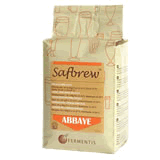
Safbrew™ Abbaye de Fermentis, la souche de levure parfaite pour dévoiler tout le potentiel d'une large gamme de recettes, change son nom en Safbrew™ BE-256.
Cette souche de levure typique parmi notre gamme est destinée à brasser une grande diversité de bières, parmi lesquelles les bières d'abbaye, connues pour leur haute teneur en alcool et / ou leur atténuation très haute. Elle fermente très vite et révèle des arômes subtils et bien équilibrés. Le champ d'application de la Safbrew™ BE-256 s'étend en fait au-delà du développement des seules bières d'abbaye.
"BE" évoque la Belgique, le pays bien connu pour ses nombreuses bières; "256" est le code de la souche de levure repris dans la gamme.
Safbrew™ BE-256 est maintenant disponible de stock. N'oubliez pas de l'inclure dans votre prochaine commande.

Des solutions logistiques et d’emballage optimales sont garanties par la Malterie du Château® à chaque livraison et un nouveau centre de distribution de 5000 m2 nous permet de fournir les meilleurs services à tous nos clients.
Une toute nouvelle ligne de conditionnement assure la mise en sacs et la palettisation à une cadence de 600 sacs par heure. La grande aire de stockage disponible sur des racks de 10 mètres de haut permet la préparation systématique de palettes complètes, et le stockage de 1.500 palettes des malts les plus demandés.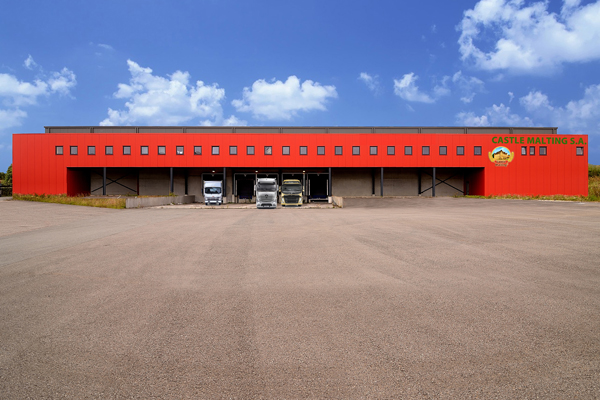
A la réception d’une commande, seules les palettes panachées – chargées de différentes variétés de malt – doivent être constituées. Cela réduit autant que faire se peut le temps nécessaire à l’assemblage d’un chargement.
L’aire d’expédition permet de préparer jusqu’à 40 commandes, qui sont ainsi prêtes pour chargement dans un délai de 24 heures !
La Malterie du Château® peut dorénavant livrer tous les malts qu’elle produit sur des palettes de 50 à 1.500 kg, toujours avec une traçabilité totale.
Le trafic des camions est lui aussi spectaculairement facilité, sur une zone de parking pouvant accueillir une vingtaine de véhicules, pour une fluidité maximum des opérations. Ce nouveau site se trouve à un kilomètre de l’autoroute et au centre des grands axes routiers européens.

Avec BrewMalt® vous pouvez obtenir toutes les informations nécessaires sur la bière et le malt, ainsi que commander tout ce dont vous avez besoin pour votre brasserie ou distillerie. Vous avez la possibilité de sélectionner et commander les ingrédients de brassage et autres produits via la rubrique BrewShop. Vous pouvez également voir tous les documents relatifs à vos commandes: analyses de malt, factures, certificats, ainsi que les listes complètes des livraisons dans la nouvelle section Services.
Grâce à la nouvelle rubrique BrewWorld vous serez encore plus près de l’industrie de la brasserie et du maltage avec accès aux dernières nouvelles, prix du marché et renseignements sur les événements. En outre, avec BrewWorld, vous serez mieux informés en profitant de l'accès aux recettes de bière, conseils de brassage, calculatrice, glossaire, histoire de la bière, etc.
Nous vous garantissons le meilleur support client dans l'industrie. Profitez-en !

La Malterie du Château® annonce un nouvel ajout à sa gamme de levure - Safbrew Abbaye de Fermentis®. La Levure Safbrew Abbaye est recommandée pour le brassage des bières d'abbaye avec un taux d'alcool plus élevé. Ce type de levure fermente très rapidement et donne à votre bière un arôme subtil et bien équilibré.
La Levure Safbrew Abbaye est déjà disponible en stock à la Malterie du Château®. Ajoutez-la à votre prochaine commande de malt afin d'économiser considérablement sur le coût de transport!



